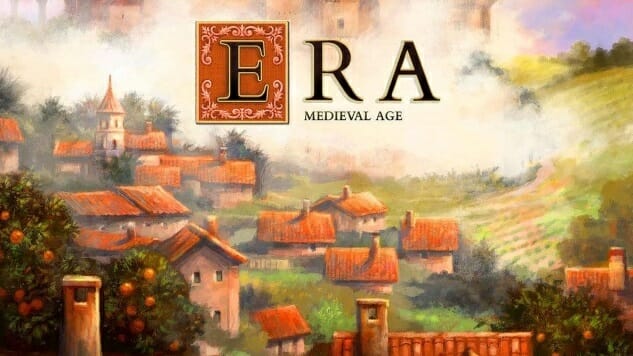Matt Leacock Revisits an Old Favorite with Era: Medieval Age

If you know game designer Matt Leacock’s name, it’s probably because of his acclaimed batch of cooperative games headed by Pandemic (and now Pandemic Legacy), a series of five core games with many brand extensions that all rely on the same core set of rules for players. He’s more responsible for the popularity of cooperative tabletop games today than anyone else.
Leacock has had one hit in the competitive gaming space, however, in Roll Through the Ages: The Bronze Age, a roll-and-write game from 2008 that borrowed the theme of the complex strategy game Through the Ages but introduced entirely new mechanics. Players would roll dice to gain resources, rerolling one or two more times but setting aside dice with hazard symbols, then using resources to build ‘developments’ or ‘monuments’ which they’d simply mark off on their own scoresheets. Where Through the Ages is a solid two hours just to play, not counting the extensive setup, Roll Through the Ages: The Bronze Age plays in well under an hour and there’s very little setup involved.
Leacock has now redesigned and rebranded his Roll Through the Ages game as Era: Medieval Age, a “roll and build” game that has the same dice-rolling and resource collection mechanics, but now comes with a slew of plastic buildings that players build by placing on their peg boards. This allows Leacock to introduce more ways to score (or to lose points), adding a spatial aspect to the game, introducing a light military conflict aspect, and giving players an opportunity to double their building points by walling in their cities. It will be very familiar to Roll Through the Ages players, but it’s also a new enough experience that it’s worth trying even if you loved its predecessor.
Era players start the game with four dice, five buildings, and two long wall segments, and then place their Keep (2×2) building at the center of their 14×14 peg board and place all other buildings wherever they’d like. They also may have to place one or two “scorched” tiles, rendering 3×3 areas useless, depending on the player count. In each round, all players roll all of their dice, and may choose to re-roll any of those dice up to two more times; once a die has one or more skulls appear, that die may not be re-rolled in this round. The revealed faces may grant the player food, which they must pay after each round, spending one food per die; wood, stone, or trade goods, resources used to buy buildings; culture, worth points at game-end; or swords and shields, used for the game’s one military-like aspect. Players spend resources to buy and place buildings, some of which give the player additional dice to roll (and feed), others of which give new resources each turn, and all of which are worth points at game-end. They may also buy walls to surround their buildings; once fully enclosed, the buildings are protected from some hazards, and are worth double the points at game-end.
-

-

-

-

-

-

-

-

-

-

-

-

-

-

-

-

-

-

-

-

-

-

-

-

-

-

-

-

-

-

-

-

-

-

-

-

-

-

-

-









































